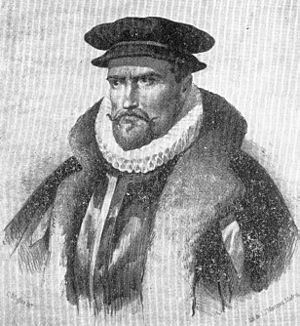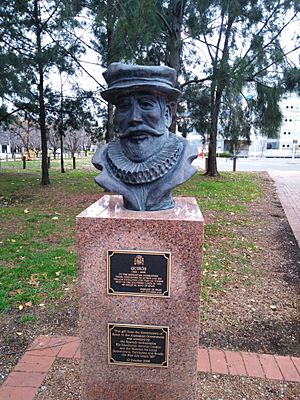Pedro Fernandes de Queirós facts for kids
Quick facts for kids
Pedro Fernandes de Queirós
|
|
|---|---|

Modern artist's impression of de Queirós
|
|
| Born | 1565 |
| Died | 1615 |
| Nationality | Portuguese |
| Occupation | Navigator |
| Known for | Spanish discovery of the Pacific Ocean |
Pedro Fernandes de Queirós (Spanish: Pedro Fernández de Quirós) was a brave Portuguese explorer and navigator. He worked for Spain during a time when Portugal and Spain were ruled by the same king. Pedro is famous for his exciting trips across the Pacific Ocean. He was part of a big journey in 1595-1596 with Álvaro de Mendaña de Neira. Later, he led his own expedition from 1605 to 1606. On this trip, he searched for a huge southern land called Terra Australis.
Contents
Early Life and First Voyages
Pedro Fernandes de Queirós was born in Évora, Portugal, around 1563. When he was young, Portugal and Spain were united under the Spanish king. This allowed Pedro to join the Spanish navy. He quickly became a skilled sailor and navigator.
In April 1595, Pedro joined Álvaro de Mendaña de Neira on a voyage. Their goal was to explore and settle the Solomon Islands. Pedro served as the main pilot on this important journey. Sadly, Mendaña died in October 1595. Pedro then took charge and saved the last ship of the expedition. They managed to reach the Philippines in February 1596. Mendaña's wife, Isabel Barreto, was also on the trip. Some people blamed her for the crew's low spirits.
Searching for the Great Southern Land
Pedro spent about a year and a half in the Philippines. He then returned to Spain in 1598, traveling through Mexico. Once in Spain, he asked King Philip III for help. He wanted to lead another voyage into the Pacific Ocean. His dream was to find a huge southern continent and claim it for Spain.
Pedro was a very religious Catholic. In 1600, he visited Rome and got support from Pope Clement VIII. The Spanish Ambassador in Rome was very impressed by Pedro. He called him a "man of good judgement" and "hard working." While in Rome, Pedro also wrote a book about navigation. He even invented two new tools for sailing.
In March 1603, King Philip III finally allowed Pedro to go back to Peru. His mission was to organize a new expedition. The main goal was to find Terra Australis, a legendary "great south land." Pedro wanted to claim this land for both Spain and the Church.
Pedro's journey to Peru was difficult. He was shipwrecked in the West Indies but eventually reached Peru by March 1605. On December 21, 1605, Pedro's group set sail from Callao. They had 160 men on three ships: the San Pedro y San Pablo, the San Pedro, and a smaller boat called Los Tres Reyes.
In January 1606, the expedition found Henderson Island and Ducie Island. They also discovered Rakahanga and the Buen Viaje Islands (now part of Kiribati). It's also likely they saw Tahiti and other islands in the Tuamotu group. Pedro's ships narrowly missed the Marquesas Islands and New Zealand. This happened because he changed his planned route.
In May 1606, the expedition arrived at islands now known as Vanuatu. Pedro landed on a large island. He believed it was part of the southern continent. He named it Australia del Espíritu Santo. This means "Southern Land of the Holy Spirit." Later, this name was changed slightly to Austrialia del Espíritu Santo. This was a clever way to honor King Philip III, who was from the House of Austria. The island is still called Espiritu Santo today. Pedro wanted to start a colony there called Nova Jerusalem. He thought this land was a huge northern part of the southern continent. He even said, "New Guinea is the top end of the Austral Land."
Pedro's strong religious beliefs led him to create a new group of knights. They were called the Knights of the Holy Ghost. Their job was to protect the new colony. However, the idea of a colony was soon given up. The local people of Vanuatu were not friendly, and the crew had many disagreements.
After six weeks, Pedro's ships sailed out to explore the coast. On the night of June 11, 1606, Pedro's ship, the San Pedro y San Pablo, got separated from the others in bad weather. Pedro later said he couldn't return to Espiritu Santo. But in reality, his crew mutinied. The bad weather just gave them a chance. The ship's captain, Diego de Prado, knew about the mutiny. He and the ship's doctor moved to the other ship. Pedro's ship, with Pedro held in his cabin, then sailed to Acapulco in Mexico. It arrived in November 1606. Some accounts say that poor leadership caused Pedro's disappearance.
Two weeks later, Pedro's second-in-command, Luis Váez de Torres, left Espiritu Santo. He had searched for Pedro in vain. Torres believed Pedro's ship had gone its own way. Torres successfully reached Manila in May 1607. On his way, he mapped the southern coast of New Guinea. He sailed through the Torres Strait, which is now named after him. This strait is between Australia and New Guinea. Torres didn't know how close he was to Australia's northern coast.
Later Life and Legacy
Pedro Fernandes de Queirós returned to Madrid in 1607. People thought he was a bit strange. He spent the next seven years living in poverty. He wrote many letters to King Philip III. He begged for money for a new voyage, sending over 65 letters. Finally, he was sent to Peru with letters of support. But the king didn't really plan to fund another trip. The royal council worried Spain couldn't afford more discoveries in the Pacific. Pedro died on the way, in Panama, in 1614. He had married Doña Ana Chacon de Miranda in 1589. They had one son and one daughter.
Records of Queirós's Voyage
Many documents still exist that describe the voyages of Queirós and Torres. The most important ones are:
- Pedro Queirós's many letters to King Philip III about his voyage.
- Torres's letter to the King of Spain from July 12, 1607.
- Diego de Prado's story and four maps of New Guinea.
- Juan Luis Arias de Loyola’s letter to King Philip IV (written around 1630).
One of Pedro's letters was translated into English in 1617. It was called Terra Australis Incognita, or A New Southerne Discoverie. A short story about Pedro's voyage was also published in English in 1625 by Samuel Purchas. This story was based on another letter Pedro wrote to the King in 1610.
Between 1762 and 1765, a British mapmaker named Alexander Dalrymple saw written accounts of the Queirós-Torres expedition. Dalrymple made a simple map that included their voyages. He gave this map to Joseph Banks, who likely shared it with James Cook.
Did Queirós Discover Australia?
In the 1800s, some Australian Catholics believed that Queirós had actually discovered Australia. They thought he found it before the Protestant explorers Willem Janszoon, Abel Tasman, and James Cook. The Archbishop of Sydney, Patrick Francis Moran, even taught this as a fact in Catholic schools for many years. He claimed that Pedro's "New Jerusalem" was near Gladstone in Queensland. This idea was supported by Pedro's own descriptions of the land. He said it was "as much as all Europe and Asia Minor."
Queirós in Books
Bitter indeed the chalice that he drank
For no man's pride accepts so cheap a rate
As not to call on Heaven to vindicate
His worth together with the cause he served.
The Australian poet James McAuley (1917–76) wrote a long poem called Captain Quiros (1964). In the poem, he showed Pedro as a hero for Catholic Christian civilization. However, he did not say that Pedro discovered Australia. The poem had strong political ideas, which made it less popular at the time.
The Australian writer John Toohey published a novel called Quiros in 2002.
The British writer Robert Graves wrote a historical novel called The Islands of Unwisdom in 1949. It describes the 1595 expedition.
Named After Queirós
The Spanish Navy gunboat Quirós was launched in 1896. It was named after Pedro Fernandes de Queirós, using the Spanish spelling of his name. When the ship was sold to the United States, it kept the name. It was called USS Quiros in the United States Navy from 1900 to 1923.
See also
 In Spanish: Pedro Fernández de Quirós para niños
In Spanish: Pedro Fernández de Quirós para niños


